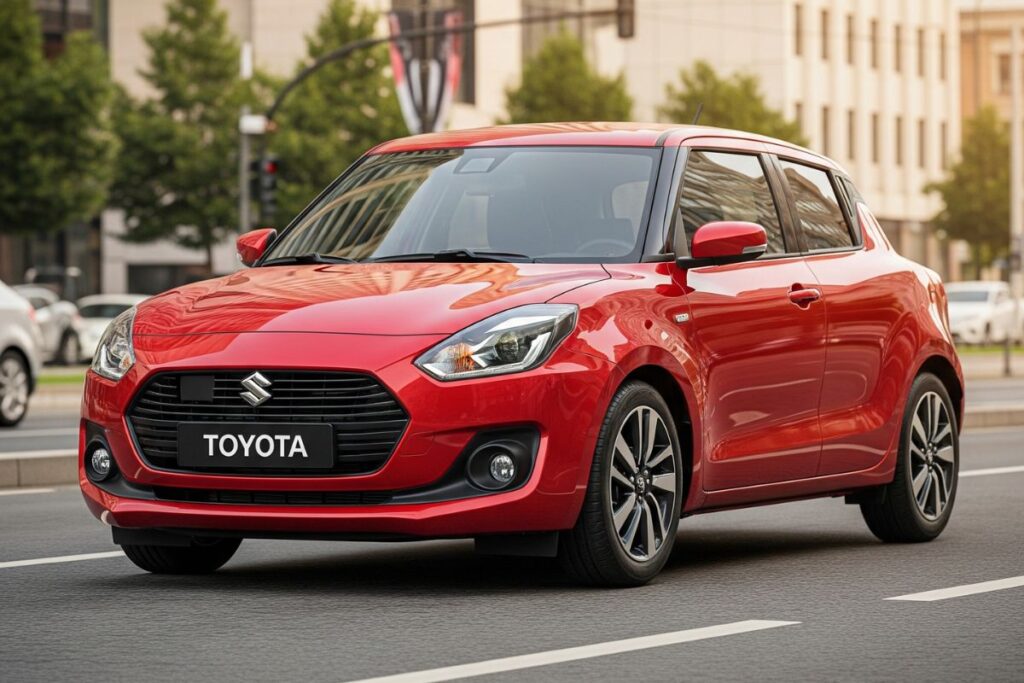TOYOTA REBADGED SUZUKI SWIFT : Are you someone who keeps a close eye on the Indian car market? Then you must have come across a lot of buzz recently about a compact hatchback that carries Toyota’s badge but looks very much like a Suzuki. Well, you’re not wrong! Toyota and Suzuki’s partnership has once again resulted in a rebadged vehicle, and this time, it’s none other than the new Toyota-badged Suzuki Swift. Yes, you heard it right. The ever-popular Swift now wears Toyota clothes!
Let’s dive into the details and find out what’s going on with this new rebadged hatchback that’s leaving people scratching their heads.
What Is Rebadging and Why Does It Happen?
First things first—rebadging is a practice where one manufacturer takes an existing car and sells it under a different brand name, often with minor cosmetic changes. This strategy helps companies expand their market reach without investing in new platforms or manufacturing processes. Toyota and Suzuki have been following this strategy in India for a few years now. Toyota Glanza (based on Baleno) and Urban Cruiser (based on Vitara Brezza) were born from this partnership.
Now, it’s the Swift’s turn to be rebadged.
Introducing the Toyota-Badged Swift: What’s New?
Toyota’s version of the Swift may not have an official name just yet, but it’s already creating waves. Although the car’s silhouette and body remain largely unchanged, Toyota has added its own identity through a new front grille, slightly tweaked bumpers, and of course, the Toyota logo. Everything else—from the body lines to the rear—screams Swift.
Let’s take a closer look at what this car offers:
| Feature | Toyota Rebadged Hatchback (Swift Base) |
|---|---|
| Platform | HEARTECT (Same as Suzuki Swift) |
| Engine | 1.2L DualJet Petrol Engine |
| Power Output | Approx. 89 bhp |
| Transmission | 5-Speed Manual / AMT |
| Fuel Efficiency | Around 22-24 kmpl |
| Infotainment | 9-inch touchscreen with Android Auto & Apple CarPlay |
| Safety | Dual airbags, ABS, ESP (top variants may offer 6 airbags) |
| Price Range (Expected) | ₹6.5 – ₹9 lakh (ex-showroom) |
So, What Makes It Different From the Swift?
That’s a valid question. Mechanically and structurally, it’s the same car. But Toyota may fine-tune the suspension and steering to make it feel a little different behind the wheel. The design elements—grille, logo, and possible interior trim changes—give it a slightly distinct look, though not enough to make it unrecognizable.
Toyota might also add its standard warranty package and after-sales support, which some buyers prefer over Maruti Suzuki’s offerings.
Why Is Toyota Doing This?
This rebadging move allows Toyota to offer a fuel-efficient, affordable hatchback in the sub-₹10 lakh market without investing in R&D. While Toyota has been dominant in the premium SUV and MUV segment (like with the Fortuner and Innova), it lacks small cars in its lineup. This rebadged Swift helps fill that gap and gives Toyota a fighting chance in the highly competitive hatchback space.
Can It Outsell the Original Swift?
Now, here’s the big question—can it beat the Suzuki Swift in sales? Probably not. The Swift enjoys massive popularity in India with strong brand recall, especially among first-time buyers and youngsters. However, Toyota’s version could attract buyers looking for something a little different with better service and longer standard warranty support.
Also, Toyota might position this car slightly differently—either a more premium variant or a more value-for-money base model—to appeal to a niche set of customers.
Should You Buy One?
If you’ve always liked the Swift but wanted something a bit unique, this Toyota version could be the perfect fit. Here’s why you might consider it:
-
You like Toyota’s brand image and after-sales service
-
You want a Swift-like car with a slightly different design
-
You’re looking for a fuel-efficient and practical hatchback
-
You’re okay with minor changes and rebadging
Conclusion
So, is it a Toyota or a Suzuki? The answer is both! This new rebadged hatchback is a clever move by Toyota to offer something fresh without reinventing the wheel. Whether it turns out to be a massive success or a niche favorite depends on how Toyota prices and markets the vehicle.



